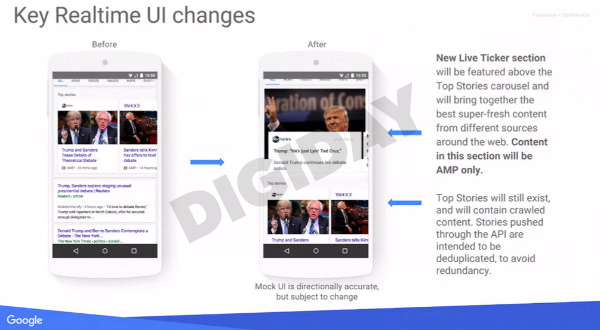Register by Jan 13 to save on passes and connect with marketers from Uber, Bose and more
Pitch deck: Inside Google’s plans to give AMP pages more prominence in search results

Google is working on an update to its fast mobile pages initiative, known as AMP or Google’s Instant Articles, that will surface breaking news and real-time alerts to the top of mobile search results.
In a presentation Google has made to several publishers this summer, the company has outlined plans for a new “live ticker” section, which will be placed above the “top stories” carousel that currently shows up during mobile search results. The ticker will present “the best super-fresh content from different sources around the web,” and content in the section will be AMP only, Google says in the presentation.
The carousel will sit underneath, followed by normal search results as users scroll down the page. AMP content presented in the both sections will be “de-duplicated” in order to avoid redundancies, Google says. The move is significant in that AMP results will now take up an entire phone screen, based on the example Google shows in its pitch deck.

The update is expected to arrive sometime in the fall, according to a publishing source who has been pitched by Google. When reached for comment, a Google rep pointed to Google’s product roadmap for AMP, which includes plans for making it easier for publishers to update existing articles within AMP as well as support for “immersive video viewing experiences.”

Beyond a new section for breaking news and alerts, Google also appears to be updating AMP to support more content types — not just written articles and videos. A different slide in Google’s presentation shows how AMP could support the publishing of articles, videos, live videos, galleries, quotes, listicles and more.

“That’s huge for us,” said Boris Park, vp of product for LittleThings, which hasn’t been pitched by Google on this particular update. “The best layout and structure for a recipe is vastly different from a viral video about a dog. It’s something we are exploring on our own site, and as we distribute more externally, we’re looking for that, as well, from partners.”
Launched by Google in February, AMP is the company’s initiative to speed up the mobile web by allowing publishers to distribute articles directly within search results. It’s akin to Facebook’s Instant Articles product and part of a general move by platforms to have more content accessed on the platforms rather than sending users out to sites. Typically, AMP pages load four times faster and consume 10 times less data than normal web pages, Google said. Since launch, the product has been adopted by publishers across news, entertainment, travel, food and other verticals. The AMP index today has more than 150 million AMP documents and adds 4 million new documents every week, said Google.
Earlier this week, the company announced that AMP will be expanded to all mobile search results, not just the top carousel. Soon, when users search for a story, if it has an AMP-supported version, they will be directed to that instead of the traditional site.
And yet, even with growing adoption of AMP, publishers are still mixed on the ultimate value of the product. They confirm that it’s speeding up load times, but some argue that the product is not driving much traffic. Monetization from advertising is not all the way there, either.
“It’s great,” said Chris Schieffer, senior product manager at The Slate Group, which started using AMP in April and has seen 25 percent in additional traffic because of the product. “In terms of size, we’re a second-tier publisher behind The [New York] Times, the [Wall Street] Journal and the [Washington] Post. We are fighting with those guys for a spot in the carousel. Opening up AMP where it’s not strictly in that carousel is going to be huge.”
Image via Fotolia / Balazs Kovacs Images
More in Media

Why publishers are building their own creator networks
Publishers are forming creator networks to regain control, combat traffic declines, and reach audiences shifting toward influencers.

The accidental guardian: How Cloudflare’s Matthew Prince became publishing’s unexpected defender
Cloudflare’s day job is fending off botnets and nation-state cyberattacks, not debating how Google and other AI firms crawl publisher sites.

A timeline of the major deals between publishers and AI tech companies in 2025
Here’s a list of all the major deals signed between publishers and AI tech companies in 2025.





